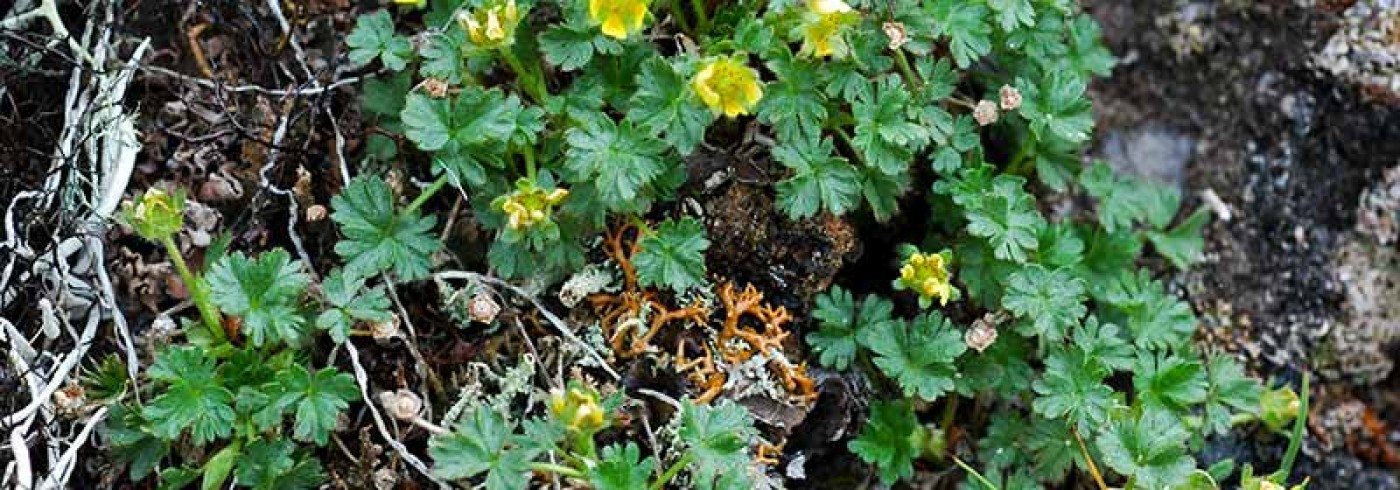Lichens in an Arctic environment
Lichens are an important part of Arctic vegetation as they are less affected by the coldness of these areas compared to many other organisms. In dry areas especially, they are a dominant group of organisms that contribute to a major part of the organic production. As they are double organisms containing both a fungal and an algal partner in their thallus, they form small ecosystems by themselves which raises questions regarding the allocation of different substances between the organisms. They are early colonizers of the barren ground when the ice retreats after the glaciations. All these properties make them suitable organisms for a range of scientific studies. Thus, the participating lichenologists have collected and studied material for a variety of scientific purposes including the general project for Theme B, Biodiversity in the arctic tundra.
One of the main objectives of the strict lichenological projects was to collect material to study the nitrogen allocation in the lichen thallus. Responsible for this project is Dr Kristin Palmqvist of Umeå University and the major work will be carried out by Lena Dahlman as a Ph.D project. With this project we hope to answer questions like: What proportion of the nitrogen available is used for cell wall formation in fungi and how much is used for membranes in the photosynthetic mechanism of the algae? Are there differences in these proportions under different ecological conditions?
One other main objective was to collect material for DNA studies to describe the colonization routes of the different populations after the last glaciation and to try to find the refuges for these. Another important objective was to describe the genetic variation among these mainly sterile taxa.
Other aims were to collect material for taxonomists working on different groups of lichens to increase the knowledge of the lichen vegetation in these poorly studied areas. A further important objective was to collect material for Professor H. Borg’s study of the deposition of different substances in the lichen thallus.
Field-work and work on board
As a part of the Biodiversity theme the lichen project participated in the vegetation analysis at each site. About a quarter of the effective working time at each site was used for this common project, since the biodiversity project has been presented in detail elsewhere in this report.
On board, the collected material was dried and prepared for the different analyses. A large part of the time was used for determining lichens and on the first leg, on which no bryologist participated, bryophytes. All data for the vegetation analyses were gathered together to avoid extra work at home.
The major part of time ashore was spent collecting lichens in as many different habitats as possible. This was mainly carried out in the form of 4-10 hour long excursions during which as many different habitats as possible were visited in order to find as many species as possible.
The collections made during the expedition comprise ca. 1 800 samples which include ca. 100 different sets of two to five duplicates for the nitrogen allocation project at Umeå University (Palmqvist & Dahlman) and ca. 40 duplicates for the project of H. Borg at Stockholm University. The original material will be deposited at the Museum of Evolution at Uppsala University (UPS, Mattsson) and the Botanical Museum at Lund University (LD, Westberg).
Preliminary results
Concerning the lichens in the Biodiversity project, we can provide some preliminary figures showing the variation in diversity between the different sites visited. Table 1 includes macrolichens and some easily identified species of crustose lichens found in the dry (xeric) and intermediate (mesic) squares of the vegetation analysis. The vegetation of the wetlands was not included in the project and these areas contained almost no lichens at all. The total number of all identified species at each site is found in the last column. These figures below include not only the species of the vegetation analysis hut also all species at the sites found within 5 to 10 km of the camp.
One of the objectives of the biodiversity theme was to study the variation in diversity at species level along different gradients. There are no clear trends in lichen diversity in the xeric and mesic lichen communities correlated to geographical position. When data of other organisms are available it will be possible to study the relative diversity which may supply more relevant information.
It is premature to give any results from the strict lichenological projects. However, we have collected in areas never or rarely visited by lichenologists before and helped increase knowledge of the distribution of many lichens. We know we have in our possession material that makes it possible to understand different distribution patterns and we have collected material that will be useful for ourselves and other lichenologists in taxonomic studies of different groups.
Dates
June–September 1999
Participants
Principal investigator
Jan-Eric Mattsson
Museum of Evolution, Evolutionary Biology Centre, Uppsala University
Sweden
Principal investigator
Kristin Palmqvist*
Department of Ecology and Environmental Science, Umeå University
Sweden
Martin Westberg
Department of Systematic Botany, Lund University
Sweden
*Not participating in the expedition


